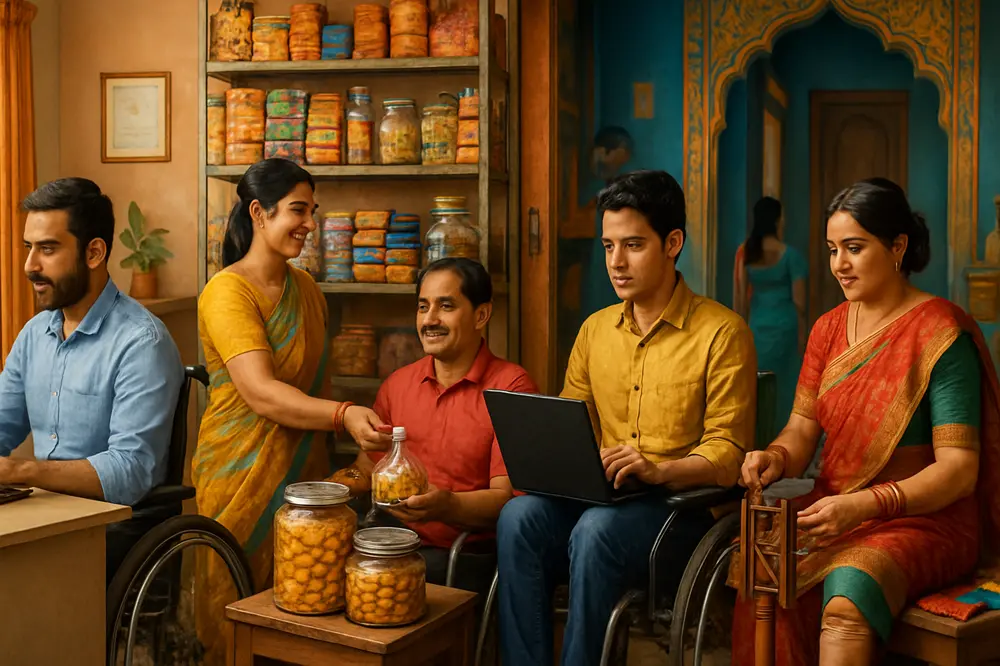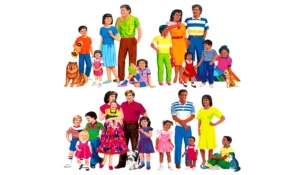Millions of disabled people in India face employment challenges. Creating equal opportunities for disabled people is key to growth.
Employment opportunities for disabled people in India are growing, but challenges remain. Many NGOs and companies now offer inclusive jobs, like tech roles, teaching, and rehabilitation work.
Many Platforms help match candidates with employers. Government schemes also support training and placement. Still, awareness and accessibility need improvement.
With the right support, disabled individuals can thrive and contribute meaningfully to society. Inclusion benefits everyone.
Discover practical ways to improve employment opportunities for disabled people in India in 2025. Learn about skill development, inclusive workplace policies, assistive technology, and government-private sector initiatives that can build a more inclusive workforce.

How to Improve Employment Opportunities for Disabled People in India in 2025?
In today’s fast-changing world, having a job is more than just earning money—it’s about dignity, independence, and equal participation in society.
Yet, in India, millions of people with disabilities still struggle to find fair employment opportunities. Despite being skilled and capable, they often face barriers such as inaccessible workplaces, lack of awareness, and social stigma.
As we step into 2025, the time has come to look at employment for disabled people from a fresh, solution-oriented perspective.
With new technology, government policies, and changing corporate attitudes, we have a golden chance to create an inclusive workforce.
In this article, we will explore the current situation, the challenges, and practical steps that can truly transform lives. Let’s discover how India can unlock the full potential of its differently-abled citizens.
The Current Employment Landscape in 2025
India is home to more than 26 million people with disabilities, yet their employment rate remains much lower than the national average.
According to recent government surveys, only a small percentage of disabled individuals are employed in formal jobs.
While the Rights of Persons with Disabilities (RPwD) Act ensures 4% reservation in government jobs, many positions remain vacant due to lack of awareness, accessibility barriers, or mismatched skill sets.
In 2025, the landscape is slowly shifting. Some state governments have started inclusive hiring drives, and corporate India is gradually realizing the benefits of diversity.
Companies in IT, retail, and e-commerce are opening doors for differently-abled employees, particularly in roles that can be adapted to their strengths.
Still, challenges persist. Many employers hesitate due to misconceptions about productivity or additional costs for accessibility. The informal sector continues to absorb most disabled workers, often at lower pay and without job security.
The reality is clear: India has policies in place, but the implementation gap is wide. Bridging this gap requires stronger enforcement, better skill training, and collaboration between government, private sector, and civil society. 2025 can be the turning point—if action matches intent.
Skill Development and Training
For disabled people, the first barrier to meaningful employment is often the lack of skill-based training.
Traditional education systems in India still fail to address their specific learning needs. In 2025, the focus must shift to practical training that aligns with industry requirements.
Government-backed programs such as Skill India and special vocational training centers have already created opportunities in fields like tailoring, handicrafts, and IT services. But the real change comes when these programs are customized.
For instance, visually impaired learners may benefit more from computer-based training, while those with mobility challenges may excel in online freelancing and remote services.
Technology now makes skill-building more accessible. Online platforms like Coursera, Udemy, and Indian government portals provide free or low-cost digital learning.
NGOs are also stepping in with job-readiness workshops. What’s needed is more outreach—bringing these programs to rural areas where the majority of disabled people live.
Partnerships with industries are equally important. Companies can collaborate with training institutes to create a direct pipeline from learning to employment. This not only improves job readiness but also builds confidence among disabled individuals.
With the right skills, disability no longer remains a barrier but a stepping stone to growth.
Technology as an Enabler
Technology is proving to be one of the biggest game changers for disabled people seeking jobs.
In 2025, assistive devices and digital platforms are helping bridge the gap between talent and opportunity.
Screen readers, voice-to-text software, and AI-powered communication aids are making it easier for people with visual, hearing, or speech impairments to engage in professional work.
The rise of remote and hybrid jobs is another blessing. Many individuals who face challenges with physical mobility can now work from home as customer support agents, coders, content writers, designers, or educators.
Freelancing platforms are also opening doors, allowing disabled individuals to become financially independent without facing daily commuting hurdles.
Moreover, Indian startups are designing low-cost assistive technologies tailored for local needs.
Affordable prosthetics, smart wheelchairs, and specialized mobile apps are reducing barriers at workplaces.
Some companies are even investing in virtual reality (VR) training for disabled employees, helping them learn new skills in a safe and interactive environment.
The key, however, lies in awareness. Employers must be encouraged to adopt these technologies and provide them to employees as a standard inclusion measure.
Technology has already proven it can level the playing field—what’s needed now is wider adoption.
Inclusive Workplace Policies
Even the most skilled employee cannot thrive in a workplace that isn’t inclusive. In 2025, companies in India are slowly waking up to this reality.
Inclusive workplace policies mean more than just hiring—they involve creating an environment where disabled employees feel respected, supported, and empowered.
Basic accessibility is the starting point. Offices must have ramps, elevators, accessible washrooms, and adaptive software. But inclusion also extends to attitudes.
Many disabled workers leave jobs not because of physical barriers, but due to workplace bias or lack of understanding.
Sensitization programs for managers and co-workers are essential to break stereotypes.
Progressive companies like TCS, Accenture, and Wipro have already launched initiatives for hiring and supporting disabled staff. These include mentorship programs, flexible work arrangements, and providing assistive technology. Smaller startups are also experimenting with remote-friendly hiring models.
Policy changes must go hand in hand with culture. If inclusivity becomes a part of the company’s values, employees are more likely to stay motivated and productive. Ultimately, inclusive policies are not charity—they’re smart business.
Diverse teams bring innovation, loyalty, and fresh perspectives. By 2025, companies that prioritize inclusion will stand out as leaders in the employment market.
Role of Government and Private Sector
Improving employment for disabled people cannot be achieved by one side alone—it requires strong cooperation between the government and private sector.
In India, the government has laid the foundation with laws like the RPwD Act, job reservations, and vocational training schemes. However, enforcement remains weak.
Many reserved jobs are left unfilled, and support systems are uneven across states.
In 2025, the government must go beyond legislation. Regular monitoring of recruitment, strict penalties for non-compliance, and stronger financial incentives for inclusive employers can make a real difference.
Additionally, expanding public sector contracts to companies that actively hire disabled employees can encourage private participation.
On the private sector side, companies need to see inclusion as a business advantage. Corporate social responsibility (CSR) funds can be used to train and employ disabled individuals.
Public-private partnerships can create large-scale employment opportunities in areas like IT services, handicrafts, and e-commerce.
One promising step is mentorship programs where industry leaders guide disabled job-seekers.
Another is internships, giving them exposure to real-world work. When both government and businesses align, employment becomes sustainable—not just symbolic. Together, they can transform inclusion into a powerful growth engine for India’s workforce.
Read Here: How Does Caste Discrimination Affect Job Opportunities in India?
Changing Mindsets Through Awareness
Perhaps the biggest challenge for disabled employment in India is not policy or infrastructure—it’s mindset.
Social stigma often overshadows talent. Many people assume that disabled individuals are less capable, which discourages employers from hiring them and families from supporting their career ambitions.
In 2025, awareness campaigns are crucial. Schools can play a vital role by teaching inclusivity from an early age, normalizing disability as part of human diversity. The media too has the power to reshape narratives.
Positive stories of successful disabled entrepreneurs, professionals, and innovators can inspire both society and employers.
Workplace sensitization is another powerful tool. Training sessions that address unconscious bias help teams work better together.
Encouraging employee resource groups for disabled staff also builds confidence and community.
Entrepreneurship is another promising path. With microloans, government schemes, and digital platforms, many disabled people can start small businesses, becoming job creators instead of job seekers. Their stories challenge stereotypes and inspire change.
Ultimately, changing mindsets is about seeing ability, not disability. By promoting empathy and respect, India can move beyond charity-based thinking to true inclusion.
Awareness is not a side effort—it’s the foundation of an equal and just employment system.
Read Here: Long-Term Economic Cost of Child Labor in India
Conclusion
Employment for disabled people in India is not just about filling quotas—it’s about building a society where everyone gets a fair chance to succeed.
As we move through 2025, the solutions are clear: skill development, assistive technology, inclusive policies, stronger government action, private sector involvement, and above all, a change in social mindset.
An inclusive workforce doesn’t only benefit disabled individuals; it strengthens the entire economy by bringing in diverse perspectives, innovation, and resilience.
Every step towards accessibility and equality creates opportunities that go beyond jobs—it creates dignity and hope.
The future can be brighter if we collectively commit to action. With government, businesses, and society working together, India has the potential to become a global example of inclusive growth.
2025 can be remembered as the year when India turned intent into impact—for millions of its differently-abled citizens.
Read Also: The Social Dynamics of Gig Economy Labor





